|
|
|
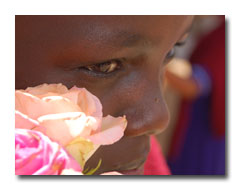 |
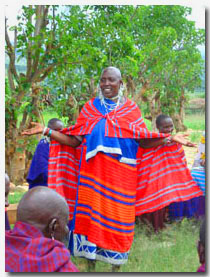 Sauti Moja is working closely with communities to mobilize them, build capacity among leaders, develop good awareness about the disease, and most importantly, stimulate local responses to confront the HIV/AIDS epidemic. Rather than simply educating people, we’re mobilizing them and giving them the tools to take on-going action in their communities! Sauti Moja is working closely with communities to mobilize them, build capacity among leaders, develop good awareness about the disease, and most importantly, stimulate local responses to confront the HIV/AIDS epidemic. Rather than simply educating people, we’re mobilizing them and giving them the tools to take on-going action in their communities!
The challenge
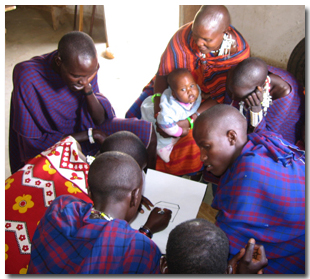 Pastoralists, including the Maasai, are some of the most vulnerable people to HIV/AIDS. The epidemic threatens to devastate them and further undermine their capacity to cope with all the other challenges they face as Indigenous People. Pastoralists, including the Maasai, are some of the most vulnerable people to HIV/AIDS. The epidemic threatens to devastate them and further undermine their capacity to cope with all the other challenges they face as Indigenous People.
HIV/AIDS is devastating communities all over the world. In Tanzania, up to 8% of the population is infected with the disease and subsequently, millions are facing the dire consequences of death, illness, and the incredible costs (financial and otherwise) of caring for sick family members. Entire institutions, such as schools, have been undermined due to the loss of human resources. Over a million children have been orphaned!
For pastoralists, like the Maasai, who depend on caring for livestock, the epidemic has terrible ramifications. Their livelihood fundamentally depends on large numbers of healthy adults and older youth who are healthy enough to care for the livestock, which includes walking long distances to find grazing land and water.
The Maasai are especially vulnerable due to a host of socio-cultural factors, but most significantly, they haven’t been provided adequate health programs due to discrimination and the remote areas in which they live.
With so many lives lost and threatened, who will care for the children and herd the livestock?
|
|
|
When we started the Community Conversations method in the first community, no one had ever disclosed their HIV status. The community was unaware of the imminent threat of the disease and the existing impact. Very little testing had been conducted. No one was being treated. Few activities were being conducted.
Today, community leaders are volunteering their time to conduct prevention and care activities, many are getting tested, and a large number of people are on ARV treatment to prolong their lives. We can’t enter the community without being confronted with more infected or affected people, who share their stories and seek support. While overwhelming, it’s an indication that we’ve done something right – the community is facing the reality of and confronting AIDS.
One man recently stated, “My wife tested positive. Our newborn recently died. For the longest time, I wasn’t tested. I was scared. Then, a home-based care worker for the Community Conversation’s project came to my house. He counseled me for four months. Recently, I got tested. I am positive. With help from Sauti Moja, my wife and I are on drugs, our health has improved. I have more hope for my children!” |
| |
|
|
Our Response
Sauti Moja is adopting an innovative approach called Community Conversations to help communities prevent the disease and care for those living with it.
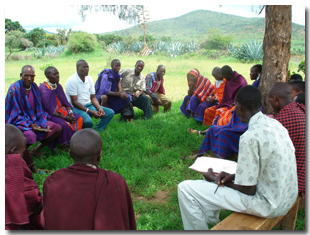
Helping the community progress through the stages of CC includes facilitating frequent, regular meetings with a core group of leaders and community members over a long period of time – sometimes up to a year! The purpose of these meetings is to build understanding of the disease and its impacts, as well as to support them in development of plans for prevention, testing, treatment, and care. Once communities start initiating some local activities, we keep on supporting them with the necessary financial resources and technical support. The CC method accompanies communities through a change process via the following six steps:
- Relationship Building. Building trust and thorough awareness of the situation in the community is the most important element in ensuring success of subsequent steps.
- Concern Identification. This is where we begin to facilitate discussions and activities to identify the local factors contributing to the spread of the disease.
- Concern Exploration. It isn’t enough to simply identify the factors, communities must understand them deeply, with a focus on getting at the roots of the problems.
- Prioritizing & Planning. This is an important stage wherein the community prioritizes and plans activities to alleviate or resolve the concerns they’ve discussed.
- Community Action. Leaders and community members volunteer their time to implement their plans relating to prevention, testing, care and treatment.
- Reflection and Review. Ongoing acknowledgement and discussion of progress being made helps communities improve their plans and projects and also serves to motivate continuing community engagement in the process.
The cycle never ends. Communities continue to work through the stages, identifying key issues, planning solutions, conducting activities, and reflecting on achievements. We will meet the challenge through community perseverance and on-going action!
Our Achievements
-
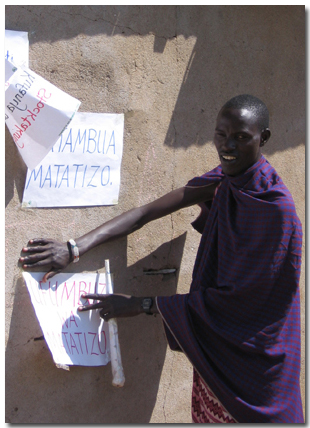 Community members have new skills and tools. First and foremost, Sauti Moja provides training and teaches community facilitators and other leaders about the tools they can use to enlighten and mobilize their communities. This consists of participatory methods for education and planning. Community members have new skills and tools. First and foremost, Sauti Moja provides training and teaches community facilitators and other leaders about the tools they can use to enlighten and mobilize their communities. This consists of participatory methods for education and planning.
- Leaders are mobilized and educated. The CC method brings local leaders and community members together in frequent, regular meetings for up to a year, wherein, with the help of community facilitators, they learn about the disease, and then, discuss, debate, and plan ways to respond.
- Women have a voice. Women are often marginalized, but are key actors in achieving our objectives. Our emphasis is on ensuring that they have a voice and that their experiences are well-considered. In all our projects, women remain prominent participants...not mere beneficiaries.
- Communities are reaching mutual understanding and agreement. One of the biggest impediments in communities is that there are many different ideas of what the problem is and how to address it. Through the CC project, we’ve managed to facilitate mutual understanding and agreement about the epidemic, which helps communities move into action.
- Communities are taking action. The communities we’ve worked with are conducting the following activities:
- Counselling A few women spend two days a week at the local clinic, counseling women, especially those who are pregnant, about the disease, its treatment, and care for those infected. Recently, a group of men and women who are living with AIDS have begun counseling those visiting the local medical clinic and newly-identified as HIV+.
- Mobilizing leaders in hard-to-reach villages. Volunteers are taking the CC method and beginning to use it in their respective communities that are often remote and have no health programs.
- Condom promotion and targeting male youth Previously, condoms weren’t discussed, and the sexual behaviour of males wasn’t confronted. Now, trained male youth are meeting with their peers on a weekly basis to promote condom use and behaviour change. A small resource centre is in the works, which will provide a location for male youth to discuss issues and get information.
- School education The community identified that no education about HIV/AIDS was being provided in the local schools, so now, groups of volunteers are conducting education activities every week in every school.
- Educational drama presentations Communities have developed dramas that identify key cultural issues contributing to the epidemic, and teams are presenting these to educate others and stimulate further public discussion.
- Home-based care A few volunteers spend several hours every week visiting households with sick residents, especially those suspected of having HIV/AIDS. This has resulted in many people accessing counseling, social support, and ARV treatment.
- Educating migrant city workers – the “Walinzi challenge” (the “watchmen challenge”) A key transmission factor identified by Maasai communities is that many of their young men travel to large city centers to work as security workers and watchmen – called “walinzi” in Swahili. Due to living away from their families and the high prevalence of HIV/AIDS in cities (sometimes up to 20%), these young men are at higher risk of becoming infected and returning home with the disease. Community Facilitators are conducting weekly meetings in the city centre of Arusha to educate the “Walinzi”, and encourage safe practices.
- Livelihood support Those living with AIDS require better nutrition for survival and more food to counter the effects of the ARVs which can save their lives. However, at the same time, they have less energy for work and child care. Sauti Moja is assisting destitute families with goats to increase household milk consumption and income. Members of the extended family provide support by herding the goats.
Did you know?
In 2003, Sauti Moja Canada Program Manager, Corey Wright, was awarded a CIDA Innovated Research Award to conduct research on Maasai women’s vulnerability to HIV/AIDS. The research was conducted in the Engerenaibor community of Longido. Upon establishment of Sauti Moja Canada, the findings of Corey’s study and following work in Zambia formed the basis of the Community HIV/AIDS Program. The community was happy to see Corey’s return and many of the previous research participants are now key facilitators of the program!
|
|

- Join the LECHE Project which is affordable, supports healthy development of Maasai preschoolers, and helps educate your children.
- 1000 Widows Initiative – We’ve helped 161 vulnerable women become self-sufficient, so now we are targeting another 839 over the next three years! More
- Sponsors for child mothers are desperately needed! More
- Read about Sauti Moja’s role in famine recovery here.
- Read about Sauti Moja’s response to global warming here.
|
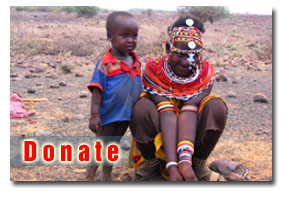 |
|
|
|